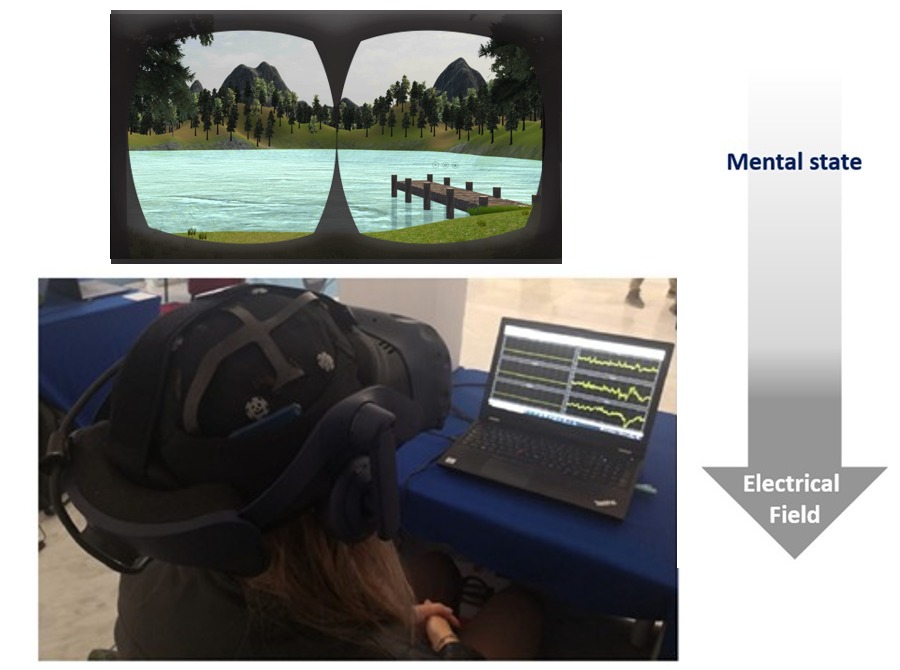
Application fields
Psychology, Psychiatry, Wellbeing
Technologies
eXtended Reality (XR), Electroencephalography (EEG), Machine Learning (ML)
Goals
In psychometric measurements, the measurand is a 'latent variable' of a given subject, accessible through the perception of the participant in the experimental activity. Mental states comprise a heterogeneous class that includes perception, pain experience, belief, desire, intention, emotion and memory. EEG-based measurements of mental states constitute a new approach that can provide real-time monitoring.
eXtended Reality (XR) is increasingly being used as an umbrella term that includes virtual reality (VR), augmented reality (AR) and mixed reality (MR) technologies. Especially with reference to VR, the high sense of presence offered, the possibility of immersion of the user in realistic scenarios, and the multi-sensory and multi-perceptual stimulation offer the subject extremely evocative experiences.
The following research goals are defined:
1-specification of the measurand: XR is able to better define and enrich the stimulus due to its ability to model complex virtual environment;
2-identification of a measurand model: XR offers highly evocative and immersive experiences resulting in an improved electroencephalographic SNR;
3-preservation of experimental reproducibility: with XR, the subject can be exposed to a governable and reproducible condition. Immersiveness ensures that all environmental variables are controlled.
Activities
- production of stimulating immersive environments and precise description of the experimental set-up;
- standardization of a XR stimulation dataset;
- definition of the stimulus-subject relationship and implementation of subject selection procedures, excluding subjects with a certain bias (e.g. depressed subjects) or selecting subjects with a certain personality profile, in order to operationally define the measurand;
- sensitivity analysis for a selection of features that maximize classification performance in order to accurately specify the measurement model;
- prototyping of experimental solutions in two application areas of interest: (i) systematic desensitization for specific phobias and (ii) mindfulness-based psychological interventions.
Challenges
- MEASURAND SPECIFICATION: a specific condition must be experimentally designed to determine the precise occurrence of the mental state;
- IDENTIFICATION OF A MEASUREMENT MODEL: standardised stimuli are currently used, but they are unable to intensively elicit the desired mental state and have poor ecological validity. A low Signal to Noise Ratio can compromise the measurement model identification;
- EXPERIMENTAL REPRODUCIBILITY: the same experiment must be carried out while keeping the fundamental variables unchanged.
Bibliography
- Arpaia, P., D’Errico, G., De Paolis, L. T., Moccaldi, N., & Nuccetelli, F. (2021). A narrative review of mindfulness-based interventions using virtual reality. Mindfulness, 1-16.
- Arpaia, P., Coyle, D., D’Errico, G., De Benedetto, E., De Paolis, L. T., du Bois, N., ... & Vallefuoco, E. (2022). Virtual Reality Enhances EEG-Based Neurofeedback for Emotional Self-regulation. In International Conference on Extended Reality (pp. 420-431). Springer, Cham.
- Arpaia, P., Calabrese, L., Chiarella, S. G., D’Errico, G., De Paolis, L. T., Grassini, S., ... & Vallefuoco, E. (2022, October). Mindfulness-based Emotional Acceptance in Combination with Neurofeedback for Improving Emotion Self-Regulation: a Pilot Study. In 2022 IEEE International Conference on Metrology for Extended Reality, Artificial Intelligence and Neural Engineering (MetroXRAINE) (pp. 465-470). IEEE.
- Gatto, C., Calabrese, L., Chiarella, S., De Luca, V., D’Errico, G., Nuzzo, B. L., ... & De Paolis, L. T. (2022, October). Wellbeing Assessment of a Museum Experience in Virtual Reality through UCL Measurement Tool Kit and Heart Rate Measurement: a Pilot Study. In 2022 IEEE International Conference on Metrology for Extended Reality, Artificial Intelligence and Neural Engineering (MetroXRAINE) (pp. 483-488). IEEE.
- Arpaia, P., D’Angelo, M., D’Errico, G., De Paolis, L. T., Esposito, A., Grassini, S., ... & Nuzzo, B. L. (2022, October). EEG features of the interaction between sense of agency and body ownership: a motor imagery BCI case study. In 2022 IEEE International Conference on Metrology for Extended Reality, Artificial Intelligence and Neural Engineering (MetroXRAINE) (pp. 104-109).
- Apicella, A., Arpaia, P., Cataldo, A., D’Errico, G., Marocco, D., Mastrati, G., ... & Vallefuoco, E. (2022, October). Reproducible Assessment of Valence and Arousal Based on an EEG Wearable Device. In 2022 IEEE International Conference on Metrology for Extended Reality, Artificial Intelligence and Neural Engineering (MetroXRAINE) (pp. 661-666).





